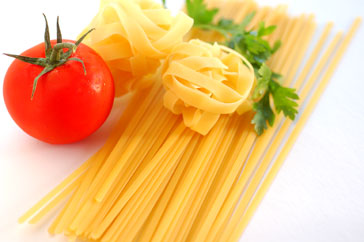How to Cook Pasta
Cooking perfect pasta, perfezionare la pasta, Italian, means cook pasta until al dente, firm to the bite. Pasta is available in different sizes and shapes topped with various sauces. Homemade fresh pasta is lighter on the stomach as it does not have semolina flour that is mainly used in the commercial pasta. Besides, it also tastes good and absorbs the sauce better.

There are several main steps needed to be done to cook perfect pasta.
Ingredients:
- Water,
- Pasta,
- Salt,
- Long handled spoon.
Cooking Time: 20 minutes
Method of cooking pasta
Fill a saucepan with enough water and bring to the boil. Add salt and 1-2 tablespoon of olive oil. Do not add salt and oil until the water is boiling.
Olive oil in the water will prevent fresh pasta and lasagna sheets from sticking together. The oil is not needed with other types of pasta however it might be added if you wish (more on this below).
Once the water starts boiling, add the pasta carefully to the boiling water. Stir for a few seconds to avoid sticking, cover the saucepan with a lid for a moment until the water will start boiling back on. When you bring the pasta to a boil, it becomes sticky on account of the exuded starch. Stir pasta briefly with a long wooden spoon to prevent it from sticking. Continue to cook it in the rapidly boiling water without the lid.
Start timing after the water returns to a rapid boil. For the best results follow the timing directions on the pasta package. Cooking times vary according to the type, size and shape of the pasta. As a general rule, dried pasta needs 12 minutes and fresh pasta can be done during 2-3 minutes only.
Check the pasta 1-2 minutes before the end of the recommended cooking time to see if it is al dente. ‘Al dente’ is translated ‘to the tooth‘ in Italian or actually firm to the bite. The pasta should be soft on the outside but still firm inside.
Lift and drain the pasta in a sieve. You should never rinse the pasta unless you’re using it for pasta salads. The exuded starch helps the pasta sauce adhere well and rinsing will get rid of this starch. A few pasta recipes also make use of a small quantity of the pasta water containing starch as it works to its advantage. It helps thicken the sauce. Pasta should not be rinsed in cold water as this would wash out the flavour.
Toss the pasta immediately with oil, butter or sauce. A number of dishes are served with the pasta on a plate and the sauce just added on top without tossing. If the pasta will be used in a cold salad drain, rinse it and immediately drain again.
Tips on cooking perfect pasta
- Using a generous amount of salt about 1-2 tablespoons in the pasta water will give it a better flavor. This may seem too much but, it’s just what the pasta needs.
- Many add a drop of oil to the water to avoid sticky slushy pasta. This is a good solution to avoid stickiness but, at the cost of the flavor. The oil greased pasta surface does not absorb the sauce flavor well thus making your pasta flavorless and bland.
- The secret behind making the pasta dish delicious lies with the sauce – when and how you combine it. Toss the pasta in the sauce while the pasta is still hot. It will absorb the flavor well. Add some garnish and serve hot. Some sauces that you can use as a topping are tomato sauce, white sauce, the traditional pesto or pesto pistachio sauce and carbonara sauce.
- Do not try to cook different types of pastas in one pot because every type of pasta requires different cooking time.
- Be careful while cooking pasta and keep an eye on timer because pasta can overcook really quickly.
